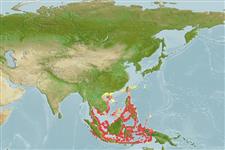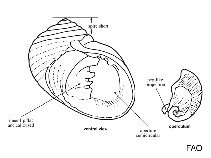Nerita exuvia Linnaeus, 1758
Snake's skin nerite| Native range | All suitable habitat | Point map | Year 2050 |

|
| This map was computer-generated and has not yet been reviewed. |
| Nerita exuvia AquaMaps Data sources: GBIF OBIS |
Upload your photos
Google image | No image available for this species;
drawing shows typical species in Neritidae.
Google image | No image available for this species;
drawing shows typical species in Neritidae.
Classification / Names Common names | Synonyms | CoL | ITIS | WoRMS
Gastropoda | Cycloneritida | Neritidae
Environment: milieu / climate zone / depth range / distribution range Ecology
Benthic. Tropical; 26°N - 9°S, 99°E - 136°E
Distribution Countries | FAO areas | Ecosystems | Occurrences | Introductions
Western Pacific.
Length at first maturity / Size / Weight / Age
Maturity: Lm ? range ? - ? cm Max length : 4.0 cm ShL male/unsexed; (Ref. 821)
Short description Morphology
Shell ovate and thick, flatly excavated at the base. Spire small, whorls narrowly rounded with spiral ribs separated by grooves. Columella widely concave, granulated and toothed. Colouration: ribs blue-black, marked with white lines, grooves whitish, spotted with blue black (Ref. 128042).
Collected by gleaning for its edible flesh (Ref. 128042). Length based on occurrence data; to be replaced with better reference.
Life cycle and mating behavior Maturity | Reproduction | Spawning | Eggs | Fecundity | Larvae
Members of the order Neritopsina are mostly gonochoric and broadcast spawners. Life cycle: Embryos develop into planktonic trocophore larvae and later into juvenile veligers before becoming fully grown adults.
Main reference
References | Coordinator | Collaborators
Springsteen, F.J. and F.M. Leobrera. 1986. (Ref. 821)
IUCN Red List Status (Ref. 130435: Version 2024-1)
CITES status (Ref. 108899)
Not Evaluated
CMS (Ref. 116361)
Not Evaluated
Threat to humans
Human uses
| FishSource |
Tools
More information
Trophic Ecology
Food items
Diet
Food consumption
Ration
Predators
Diet
Food consumption
Ration
Predators
Ecology
Population dynamics
Life cycle
Distribution
Human Related
Aquaculture profile
Stamps, Coins Misc.
Stamps, Coins Misc.
Outreach
References
Internet sources
BHL | BOLD Systems | CISTI | DiscoverLife | FAO(Publication : search) | Fishipedia | GenBank (genome, nucleotide) | GloBI | Gomexsi | Google Books | Google Scholar | Google | PubMed | Tree of Life | Wikipedia (Go, Search) | Zoological Record
Estimates based on models
Preferred temperature
(Ref. 115969): 28.5 - 29.2, mean 28.8 (based on 552 cells).



